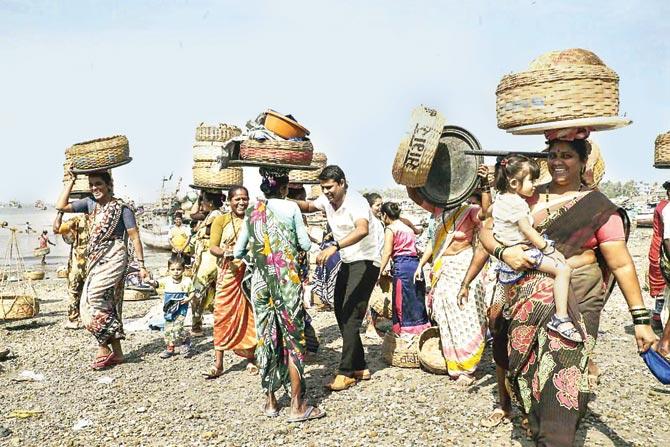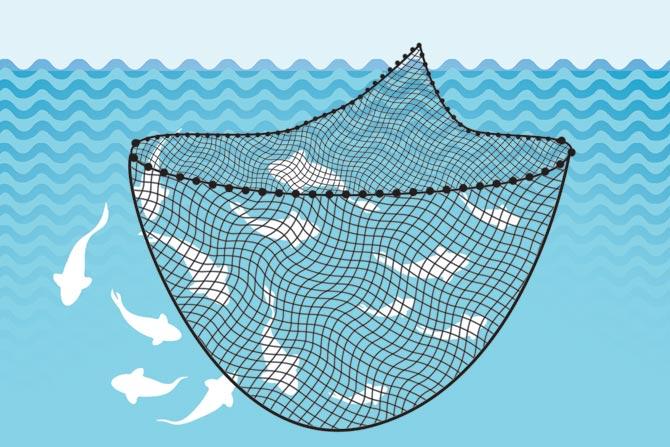Stuck between the Coastal Road project and climate change, Mumbai-s Koli community-a new documentary reveals-inds its biggest challenge in an unempathetic government that plays divide and rule

In the past few years, Mumbais Koli community has started feeling the pressure of development. Projects such as the Coastal Road and the Shivaji statue have come under the scanner for disturbing marine life. Srikant Koli (in pic) makes only Rs 2,000 per d
A typical day at Sassoon Dock begins at 5 am, with dozens of fishing boats agglomerating, and a mini army of fishers sorting their catch. Almost immediately fishing auctions begin, lasting till 11 am. On Thursday however, at 9.30 am, there-s an island of silence in the bustle. At the centre is an aged fisherwoman sitting under a shack, and fanning two pomfret to keep the flies away. "There are no fish in the sea," she rues. "This is all we could manage to catch today."
ADVERTISEMENT
A few metres away, Srikant Koli is seated at the pier, where his boat is parked. A resident of Colaba-s Sunder Nagar slum, Koli recalls setting out to the sea in 1976, "I was only 14 years old then. Today, I have a small boat of 1,000 tonne capacity that a team of six men takes into the waters every day." Until last year, his crew would earn a total of around Rs 15,000 per day after selling stocks that include singara and mushi Indian cat fish—found off the coast of Mumbai. "This year, on an average we are only making Rs 2,000 per day. Imagine dividing this meagre amount among six men. There are no fish in the sea," the 57-year-old fisherman rues.
Story of survival

Sarvnik Kaur top, in her film Fish Finger Seductions, is focusing on how traditional fishing methods are clashing with modern techniques such as purse-seine fishing and causing a rift within the community, further constricting their voice; a still from the film. Pic /Sameer Markande
Sarvnik Kaur, who in 2017 won an award at the 64th National Film Awards for Best Debut of a Director for her documentary Soz: A Ballad of Malladies, is on to her next project, which features the Koli community in Mumbai. Titled, Fish Finger Seductions, this one is an insight into the lives of two young and earnest fishermen—one from Madh Island and the other from Karanja—struggling to survive a crisis. The film which has been over two years in the making, addresses issues such as waste and sewage disposal into the sea, real estate sharks eating into the coastline, and the Coastal Road Project which has been the subject of much environmental controversy.
At her Andheri West highrise, 36-year-old Kaur discusses what drew her to the Kolis as a subject for the crowdfunded film. "My grandfather came to India from Pakistan in 1947. He got married in Delhi and then my father was born. Subsequently, it took 20 years for my grandfather to build a pucca home." In 1984, however, their home was destroyed in the anti-Sikh riots. "We lost everything, and then began our story of survival."

It was while shooting for Soz—a film that explores Kashmir-s protest culture through writings, art, music and cartoons—that Kaur read about the Coastal Road Project. "The article was basically an announcement of the project. I was in Kashmir then and immediately thought of the Kolis. I knew of them as I was living near a koliwada in Versova, and attended a seafood festival that they organise every year," She wondered how the Kolis would cope with this? "What will happen to them? Will they fight for their survival? All these questions eventually convinced me to become their voice through my film."
Yet, so much had been written on Mumbai-s indigenous community that Kaur needed to find a story that had thus far been left untold. In the film, while one protagonist practices traditional fishing methods, involving dole nets or gill nets, the other has adopted the modern purse-siene fishing technique. And, amid their separate battles to earn a living, the interference of politicians is putting them at loggerheads.

Ganesh Nakhawa
Ganesh Nakhawa, 31, a fisherman we meet at Sassoon has been doing purse-seine fishing since he was a child. His father was also a purse-seine fisherman, and Nakhawa today, owns three large boats of 15,000 tonne capacity each. A resident of Karanje, a village some two hours away from Sassoon Dock by ferry, Nakhawa says that while Koli at least gets some catch, he is completely out of work. "Purse-seine fishing has been banned in the monsoon, until July 31. We can only get into waters from August 1," says the chairman of the Maharashtra Purse Seine Fishing Welfare Association.
On the troubled history of the fishing modes in Mumbai, Nakhawa adds, "A lot of traditional fishermen, who could not catch enough stock within 12 nautical miles from the shoreline, moved to trawling in the late 1970s." But, it was short-lived. The fishermen soon realised that trawling was causing destruction to marine life. In the 1980s, they switched to purse-seine. "But the Koli community got divided into traditional and commercial fishermen. Politicians added fuel to fire by misinforming and stating that purse-seine nets can be spread over a 3-km radius, which left no catch for traditional fishermen. They are told that we are the reason for the depleting stock of marine life," he adds.
But, a senior officer with the Central Marine Fisheries Research Institute CMFRI, Mumbai, seeking anonymity, explains, "Different methods are used by fishers, depending on their economic condition. From Raigad to Palghar, the ecology supports different kinds of fish. There, you can catch Bombay Duck and non-penaeid prawn, which can be targeted only by trawlers and dole nets. Similarly, purse-siene can catch mackerel, tuna and sardine, and other bigger fish. So technically, purse-siene cannot catch fish that only traditional fishers can."
The fight within

In South Mumbai, Sassoon Dock remains one of the few places for Kolis to sell fish. With markets at Dhobi Talao and Chira Bazaar shut down, there has been a reduction in their earning capacity. Pic /Bipin Kokate
Nakhawa also feels that since traditional fishermen are larger in number, their votes are important. "During elections, local politicians ban a total of 350 purse-siene boats operating from Sassoon Dock, so they get a thumping victory by pleasing traditional fishermen. This has been going on for decades now. They have divided the community for personal gains," he shares.
Nakhawa blames industrialisation, pollution and land encroachment in coastal areas for rapid environment degradation.
Nakhawa, who also features in Kaur-s documentary, says, "In the 1990s, purse-seine was banned in territorial waters 22 km from the shore. This was done as the territorial waters are used by the traditional fishermen. In 2002, however, fishing in this area was allowed. But in 2015, a report against purse-seine fishing was submitted by Dr VS Somwanshi, who was the chairman of a government-appointed committee. Subsequently, in February 2016, purse-seine was banned in territorial waters, and was allowed in the Indian Exclusive Economic Zone EEZ instead in July that same year. "Ever since, there have been multiple cases filed against us saying we are using unscientific methods to catch fish. Even today, we are banned from entering waters in the monsoon. How do they expect us to survive?" asks Nakhawa.
Confirming climate change as the main reason for depleting fish stocks, the CMFRI officer also thinks that Kolis are over-fishing. "Both traditional and purse-seine fishermen are catching more than the optimum level. If you catch a juvenile fish that has not completed a breeding cycle even once, how will you find more fish in the sea?" the officer asks, adding, "Though the ocean is vast, the stock in it is limited. Fish need to breed, but fishermen don-t let them. In Kerala, the CMFRI introduced the minimum legal size MLS in 2017. The stringent law restricts capture of juvenile fish. We have recommended the same in Maharashtra now."
A July 2019 report released by the CMFRI shows a drop in the capture of fish in Maharashtra by 22.5 per cent since 2017. It states: "Marine fish landings catch in Maharashtra fell to 2.95 lakh tonnes from 3.81 lakh tonnes in 2017."
Hope in resolution
Narendra Patil, a member of the Sarvodaya Fishworkers Cooperative Society, Satpati, in Palghar, wants an end to purse-seine. "They leave no fish for us. The government needs to ban them for good. Nakhawa is my good friend and well educated. If his people are ready for a dialogue, we may be able to find a way," Patil says.
Kaur, who plans on concluding her project by next year, hopes that her film will help address the many problems the Kolis face today as well as unite them for the bigger fight against industrialisation and climate change. Nakhawa hopes for the same, "I have tried to start a dialogue with traditional fishers, but nothing concrete has come into being yet. But we are hopeful. The aim is to take the government to task for our suffering."
Coastal Road Project

The Supreme Court of India has issued a notice to Maharashtra government on plea of the Brihanmumbai Municipal Corporation BMC seeking stay on the Bombay High Court-s order of quashing the Coastal Regulation Zone CRZ clearances given for the southern part of BMC-s coastal road project. A Bench of Chief Justice Ranjan Gogoi and Justice Deepak Gupta has refused to stay the order and has highlighted the BMC-s plea for hearing on August 20.
The net off Mumbai-s coast

Bottom trawling: A large, heavy net is dragged along the ocean floor to scoop up everything in its path.
10k kg
Catch made per trip lasting 20 days

Purse-seine: A large wall of netting deployed around a school of fish. Once a school of fish is located, a skiff encircles the school with the net.
5k kg
Catch made per trip lasting 10 days

Traditional fishing: Fishers throw a gill net into waters and wait for an hour for a catch. They then pull out the net and segregate species.
500kg
Catch made per trip lasting four hours
Catch up on all the latest Mumbai news, crime news, current affairs, and also a complete guide on Mumbai from food to things to do and events across the city here. Also download the new mid-day Android and iOS apps to get latest updates
 Subscribe today by clicking the link and stay updated with the latest news!" Click here!
Subscribe today by clicking the link and stay updated with the latest news!" Click here!






